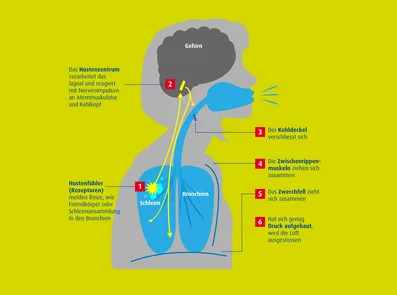Coughing – causes, types and remedies
Interesting facts about coughing

You know the feeling when the force of a coughing fit explosively propels air out of your lungs. Even though coughing can be annoying, see it for what it is: a great protective reflex of your body. You can find all the important information here.

How does coughing develop?
Coughing is an important protective mechanism of the body. The cause of coughing can be chemical or mechanical irritants that affect the airways or bronchi, such as inhaled dust particles or foreign bodies. In order to clear the airways of foreign substances, the air is expelled explosively – this allows the irritating particles to be removed and makes it possible to breathe freely again.
Another common cause of coughing—whether dry or with phlegm—is a viral infection, such as a cold or acute bronchitis. Pathogens often first settle in the upper respiratory tract and then spread to the lower respiratory tract.
The invading viruses attack the cells of the bronchial mucosa and can thus disrupt the functions of the so-called cilia. These fine hairs normally ensure that mucus – and everything caught in it – is naturally removed from the respiratory tract. This cleanses our lungs “from the inside out”, so to speak. When an infection occurs, even more mucus is produced to transport the pathogens out of the lungs. However, if the cilia can no longer perform their cleansing function, our body tries to remove the accumulated mucus by coughing. If there is a lot of mucus involved, this is referred to as a productive cough.
What types of cough are there?
In everyday life, we usually distinguish between dry or unproductive coughs and productive or mucous coughs. So what is the difference between these two types of cough?
Are there other types?
In addition to the distinction between dry and productive coughs, coughs are also classified according to their duration. This results in the subdivision of acute, subacute, and chronic coughs.
How long does a cough last?
Just like a runny nose, coughing is part of the normal course of a cold, but it usually peaks when the other symptoms are already subsiding. Accordingly, coughing often lasts longer than the other symptoms. An acute cough associated with a cold can last two weeks or longer and thus turn into a subacute cough. A dry cough can also persist for some time, even after the actual cold has passed.
-
Phase 1: Dry cough 2-3 days of dry cough without phlegm
-
Phase 2: Acute bronchitis Up to 14 days of coughing with phlegm and mucus
-
Phase 3: Dry cough Up to 8 weeks of dry cough
What to do about a cough? 3 tips for a quick recovery

Herbal medicines
Herbal medicines, such as Prospan: Herbal extracts, for example from ivy, have a long tradition in medicine. Some herbal substances—including the special ivy extract EA 575® in Prospan—have now been thoroughly researched scientifically and proven2, 3 to be effective in combating the symptoms of acute coughs.2

Chest compresses and chest rubs
For colds, especially during the runny nose phase, chest rubs with ointments containing essential oils can provide relief: pine needle, eucalyptus, menthol, or camphor. Important: Never use essential oils on infants and young children under 2 years of age! Chest compresses can also be helpful: use cold compresses for heavy sweating and hot water compresses for severe chills.

Inhalation
Inhaling salt water or chamomile tea is a good way to soothe the mucous membranes and make it easier to cough up phlegm. This moistens the mucous membranes and makes it easier to cough up phlegm. Alternatively, the hot water can also be enriched with essential oils such as eucalyptus.
What are the most common causes of coughing?
Almost every respiratory disease is accompanied by coughing. Accordingly, there are many different causes of coughing. To determine the source of the cough, it is therefore worth taking a closer look at the possible diseases.
Cold
A cold (influenza infection) manifests itself through symptoms such as a sore throat, runny nose, and hoarseness. It is also often accompanied by a cough with phlegm or a dry cough. Colds are particularly common in fall and winter, with two to four infections per year not uncommon in adults. Children can even experience coughs and colds eight to twelve times a year. Overall, the course of a cold is very individual – as a rule of thumb, without complications, symptoms should begin to subside after three to seven days and disappear after about two weeks.
Flu or influenza
The “real flu,” or influenza, is a viral flu caused by the influenza virus. There are three types of influenza viruses (A, B, C), with type A being the most dangerous. The virus is widespread throughout the world and constantly mutates, which poses a challenge when developing the respective vaccine.
It is usually transmitted through droplet infection. The “flu-like infection,” which refers to a cold, is often equated with influenza. However, caution is advised when making this comparison: influenza and a cold are not the same thing! With real flu, the symptoms usually appear suddenly and severely. Influenza usually begins with chills and a strong feeling of illness. This can be accompanied by a fever of up to 40 degrees Celsius. Other possible symptoms include a sore throat, dry cough, runny nose, watery eyes, nausea, and headaches.
Without complications, the flu usually lasts one to two weeks—bed rest is essential! However, your general state of health plays an important role. In older people, infants, or people with other illnesses, the flu can also take a severe course or even become life-threatening. In addition, the immune system is severely weakened even after the acute infection period. During the acute phase and even afterwards, the body is particularly susceptible to bacterial infections, such as pneumonia or ear infections. Coughing can also be a possible symptom of COVID-19, often accompanied by fever and a runny nose. In this case, it is important to pay close attention to your own symptoms. A rapid test or PCR test can be performed to rule out coronavirus infection. In any case, however, if you suspect you may be infected, be considerate of those around you and, ideally, limit contact with others and stay at home until the risk of infection can be ruled out.
Bronchitis
The mucous membrane of the respiratory tract responds to a viral attack with inflammation. Since the lower and upper respiratory tracts are anatomically connected and functionally similar, an infection of the upper respiratory tract, such as a cold or sinusitis, can quickly spread to the bronchi (known as a “change of level”). When this happens, the inflammation of the bronchi, known as acute bronchitis, releases chemical messengers that further irritate the bronchial mucous membrane. In addition, there is increased mucus production, which can trigger a mechanical cough reflex. The millions of tiny hairs responsible for transporting mucus are no longer able to do their job properly. As the condition progresses, the bronchial muscles may cramp up. The body tries to get rid of the mucus by contracting the muscles and coughing.
Pneumonia
The severity and duration of pneumonia depend on the pathogen and the patient's constitution. In general, however, it can be said that bacterial pneumonia is the most severe form. It is important to seek medical treatment for pneumonia. If the immune system is weakened, the risk of developing pneumonia is high. In 70 percent of cases, it is caused by bacteria, and less commonly by viruses or fungi. As the body's own defense system is weakened, the infection spreads to the alveoli. This means that breathing is impaired. Pneumonia is usually accompanied by fever, chills, and chest pain.
Asthma, bronchial asthma, and COPD
In people with asthma, the bronchial tubes react excessively to irritants that are inhaled with the air. In allergic asthma, these irritants include allergens such as animal hair, dust mites, or pollen.
There are many causes of asthma: genetic predisposition, allergies, or psychosomatic disorders. During an asthma attack, the airways constrict, creating a feeling of breathlessness. The person affected suddenly suffers from shortness of breath and the fear of suffocating. An asthma attack can be accompanied by wheezing, coughing, phlegm, and a feeling of tightness and pressure in the chest.
Medical treatment is necessary for asthmatic conditions. It is important that asthma-specific therapy is initiated early by a doctor and adhered to by the patient, especially since asthma can be treated effectively with medication.
If the lungs are permanently inflamed, this may be due to COPD (chronic obstructive pulmonary disease). In this case, the airways are constantly inflamed and narrowed. As COPD is incurable, it is important to work with your lung specialist to find a treatment that suits your individual circumstances.
What is the best way to prevent coughs?
Of course, we all want to avoid catching a cold if possible. Fortunately, there are a number of things you can do to stay healthy. Here are our top tips for preventing coughs:
When should I see a doctor?
The following symptoms require medical attention:
- Pain, rattling, or wheezing when breathing
- Severe shortness of breath during exertion
- No improvement after starting treatment
- Coughing in children under 1 year of age
- Prolonged symptoms, i.e., more than five episodes of coughing in the last 24 months.
- Purulent or bloody sputum
- Cough that lasts longer than eight weeks
- Pain, rattling and whistling noises when breathing
But don't worry: in most cases, the cough is not caused by a serious illness and usually goes away after a few weeks in healthy people. Anyone who struggles with severe symptoms for longer than this should consult a doctor to rule out a more serious cause.
Sources
1 IQVIA PharmaTrend, Absatz, MAT 12/22
2 Schaefer A. et al., Pharmazie 2016; 71(9): 504–509.
3 Lang et al., Planta Medica 2015, 81(12/13), 968-974.
https://www.pharmazeutische-zeitung.de/nach-der-ursache-therapieren
https://www.lungenaerzte-im-netz.de/krankheiten/husten-chronisch/krankheitsbild-ursachen/
https://www.aerzteblatt.de/archiv/186544/Chronischer-Husten-Was-ist-zu-beachten
https://www.patienten-information.de/kurzinformationen/copd#
Want to know more?
Don't worry, we have more helpful information and tips about coughs and colds for you.










